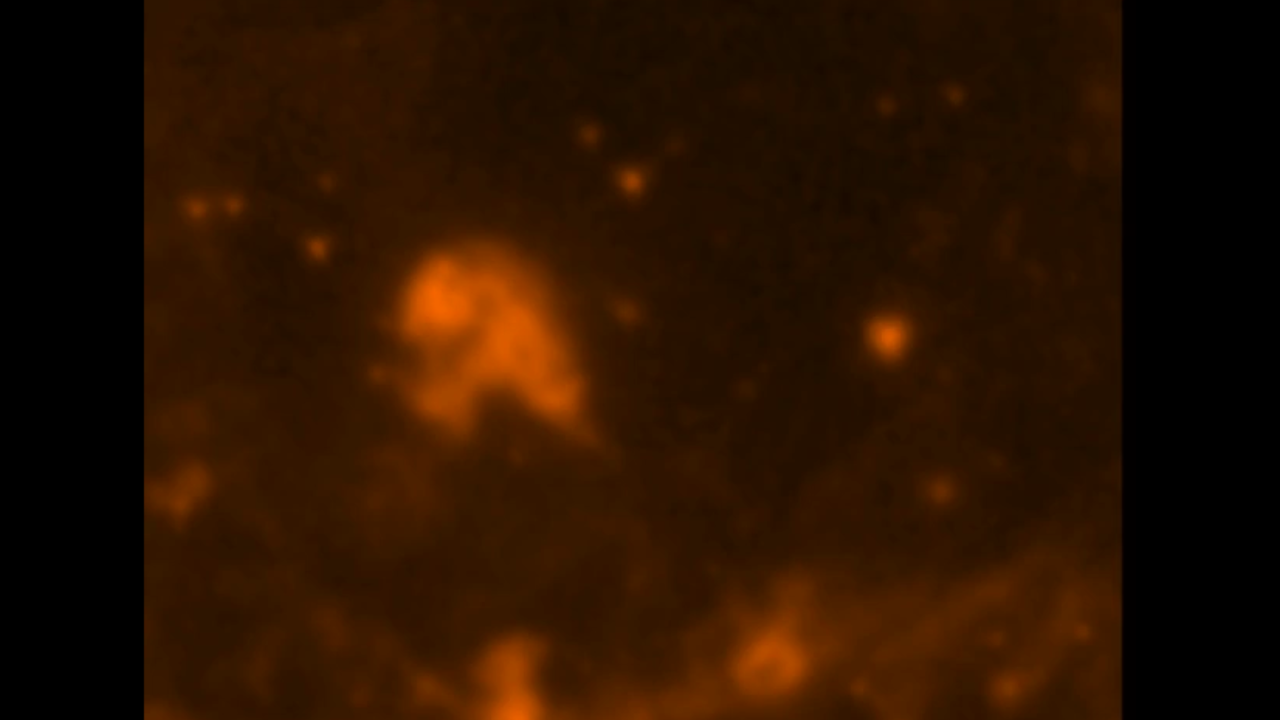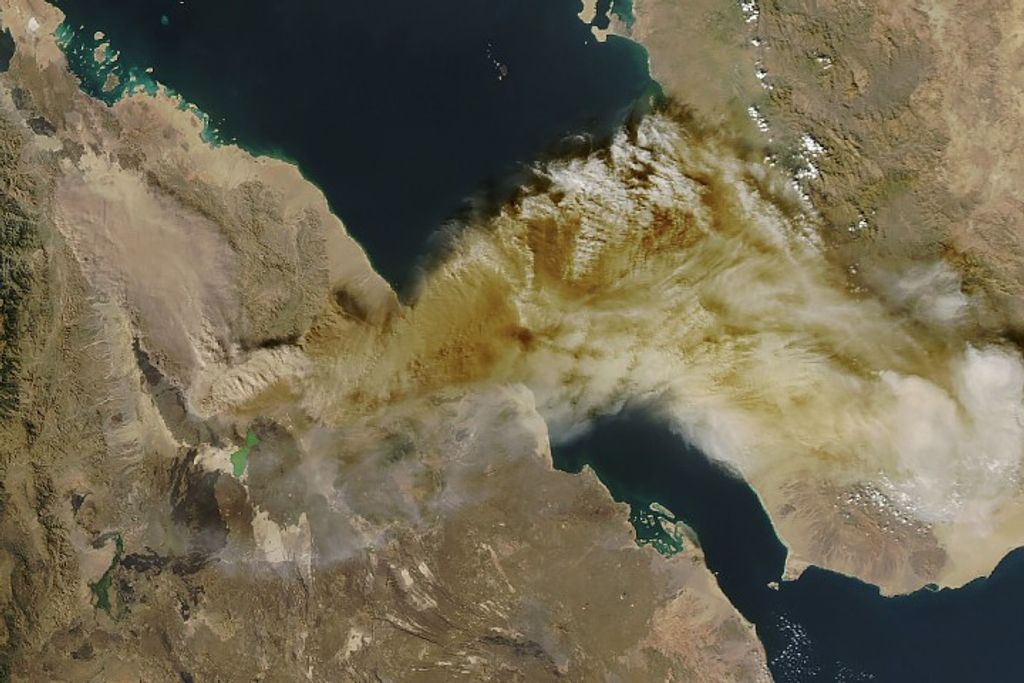1 min read
Supernova Remnant N 63A Menagerie

A violent and chaotic-looking mass of gas and dust is seen in this Hubble Space Telescope image of a nearby supernova remnant. Denoted N 63A, the object is the remains of a massive star that exploded, spewing its gaseous layers out into an already turbulent region.
The supernova remnant is a member of N 63, a star-forming region in the Large Magellanic Cloud (LMC). Visible from the southern hemisphere, the LMC is an irregular galaxy lying 160,000 light-years from our own Milky Way galaxy. The LMC provides excellent examples of active star formation and supernova remnants to be studied with Hubble.
Many of the stars in the immediate vicinity of N 63A are extremely massive. It is estimated that the progenitor of the supernova that produced the remnant seen here was about 50 times more massive than our own Sun. Such a massive star has strong stellar winds that can clear away its ambient medium, forming a wind-blown bubble. The supernova that formed N 63A is thought to have exploded inside the central cavity of such a wind-blown bubble, which was itself embedded in a clumpy portion of the LMC's interstellar medium.
Images in the infrared, X-ray, and radio emission of this supernova remnant show the much more expanded bubble that totally encompasses the optical emission seen by Hubble. Odd-shaped mini-clouds or cloudlets that were too dense for the stellar wind to clear away are now engulfed in the bubble interior. The supernova generated a propagating shock wave, that continues to move rapidly through the low-density bubble interior, and shocks these cloudlets, shredding them fiercely.
Supernova remnants have long been thought to set off episodes of star formation when their expanding shock encounters nearby gas. As the Hubble images have illustrated, N 63A is still young and its ruthless shocks destroy the ambient gas clouds, rather than coercing them to collapse and form stars. Data obtained at various wavelengths from other detectors reveal on-going formation of stars at 10 to 15 light-years from N 63A. In a few million years, the supernova ejecta from N 63A would reach this star-formation site and may be incorporated into the formation of planets around solar-type stars there, much like the early history of the solar system.
The Hubble image of N 63A is a color representation of data taken in 1997 and 2000 with Hubble's Wide Field Planetary Camera 2. Color filters were used to sample light emitted by sulfur (shown in red), oxygen (shown in blue), and hydrogen (shown in green).
About the Object
- R.A. PositionR.A. PositionRight ascension – analogous to longitude – is one component of an object's position.05h 35m 42.0s
- Dec. PositionDec. PositionDeclination – analogous to latitude – is one component of an object's position.-66° 2' 31.99"
- ConstellationConstellationOne of 88 recognized regions of the celestial sphere in which the object appears.Dorado
- DistanceDistanceThe physical distance from Earth to the astronomical object. Distances within our solar system are usually measured in Astronomical Units (AU). Distances between stars are usually measured in light-years. Interstellar distances can also be measured in parsecs.The distance to the LMC is roughly 160,000 light-years (50 kpc).
- DimensionsDimensionsThe physical size of the object or the apparent angle it subtends on the sky.This image is 1.4 arcminutes (68 light-years or 21 parsecs) wide.
About the Data
- Data DescriptionData DescriptionProposal: A description of the observations, their scientific justification, and the links to the data available in the science archive.
Science Team: The astronomers who planned the observations and analyzed the data. "PI" refers to the Principal Investigator.This image is a composite of archived Hubble observations from proposal 6698 by Y.-H. Chu, R. Williams, J. Dickel , A. Caulet, and R. Klinger (University of Illinois at Urbana – Champaign), and E.Gotthelf (Columbia Astrophysics Lab); and proposal 8110 by Y.-H. Chu (University of Illinois at Urbana – Champaign), D. Bomans (Universitat Bochum, Astronomisches Institut), G. Garcia-Segura (Universidad Nacional Autonoma de Mexico), A. Laval (Observatoire de Marseille), S. Points (Cerro Tololo Interamerican Obs.), M. Rosado (Universidad Nacional Autonoma de Mexico), K. Weis (Universitat Bochum, Astronomisches Institut), and H. Yang (Rice University). The main science team is composed of Y.-H. Chu, R. Williams, and J. Dickel (University of Illinois at Urbana – Champaign). - InstrumentInstrumentThe science instrument used to produce the data.HST>WFPC2
- Exposure DatesExposure DatesThe date(s) that the telescope made its observations and the total exposure time.October 8, 1997 and September 12, 2000, Exposure Time: 1.3 hours
- FiltersFiltersThe camera filters that were used in the science observations.F502N ([O III]), F656N (Hα), F673N ([S II])
- Object NameObject NameA name or catalog number that astronomers use to identify an astronomical object.LMC N 63A
- Object DescriptionObject DescriptionThe type of astronomical object.Supernova Remnant
- Release DateJune 7, 2005
- Science ReleaseSupernova Remnant Menagerie
- CreditNASA, ESA, HEIC, and The Hubble Heritage Team (STScI/AURA); Acknowledgment: Y.-H. Chu and R. M. Williams (UIUC)

Related Images & Videos

Chandra 3-Color X-ray Image of N 63A
Chandra's image of N63A shows material heated to about ten million degrees Celsius by a shock wave generated by the supernova explosion. The fluffy crescent-shaped X-ray features that appear around the edge of the remnant are thought to be fragments of high-speed matter shot out...

Supernova Remnant LMC N 63A in X-Ray, Optical and Radio Radiation
Chandra has imaged the glowing shell created by the destruction of a massive star. X-rays from Chandra (blue), combined with optical (green) and radio (red) data, reveal new details in the supernova remnant, LMC N 63A. The X-ray glow is from material heated to about ten million...

Supernova Remnant Menagerie
The Hubble Space Telescope's Wide Field Planetary Camera 2 (WFPC2) was used to obtain images of a violent and chaotic-looking mass of gas and dust known as N 63A. The dissolve sequence builds from a Spitzer telescope infrared image of the area, adding the Chandra X-ray image,...
Share
Details
Claire Andreoli
NASA’s Goddard Space Flight Center
Greenbelt, Maryland
claire.andreoli@nasa.gov


































